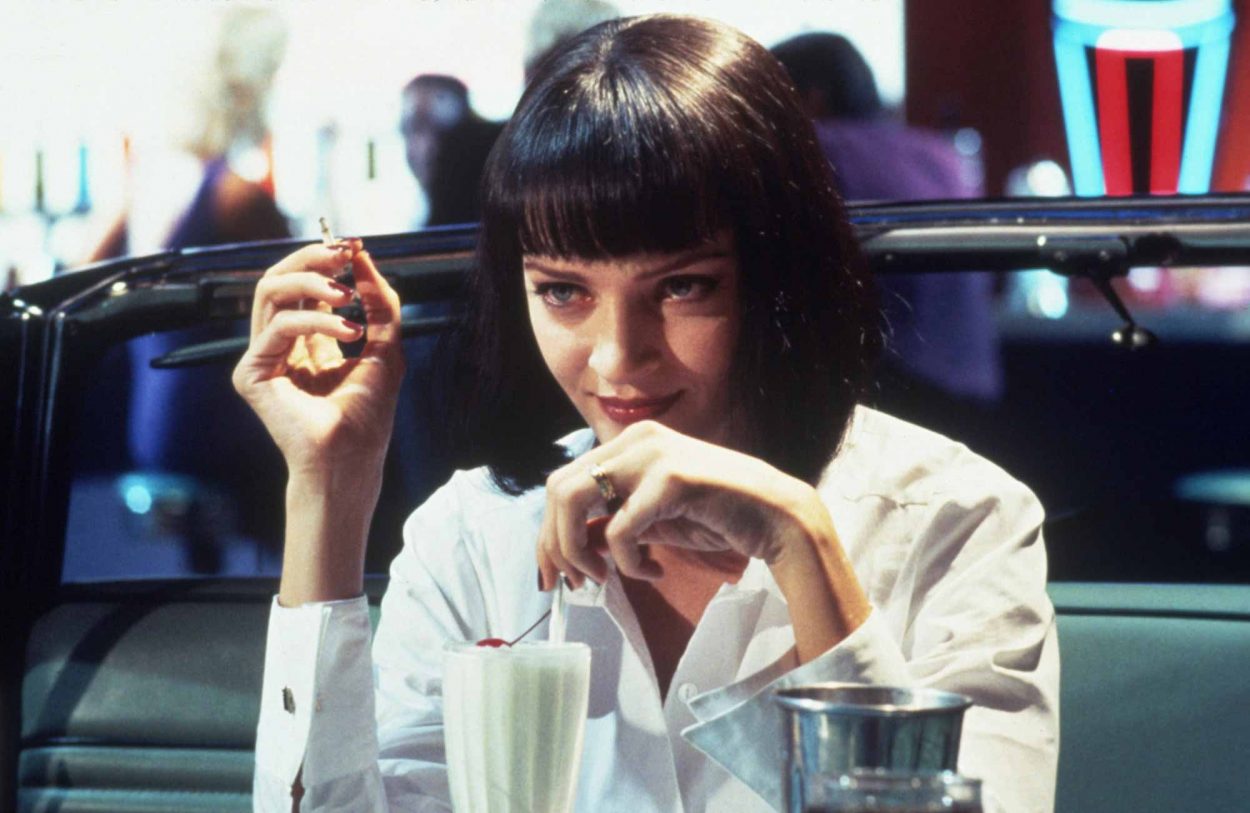“There is a very beautiful story named World on a Wire. It talks about a world where you can create projections of people with a computer. And this brings about the question to what degree we are all merely projections, because according to this thought model; the projections are equal to reality. Maybe another, larger body has created us as a thought model? We are looking at an old philosophical model that produces a certain horror. With this movie I have attempted to work as perfectly and orderly as possible, using all available technical means.” – Rainer Werner Fassbinder
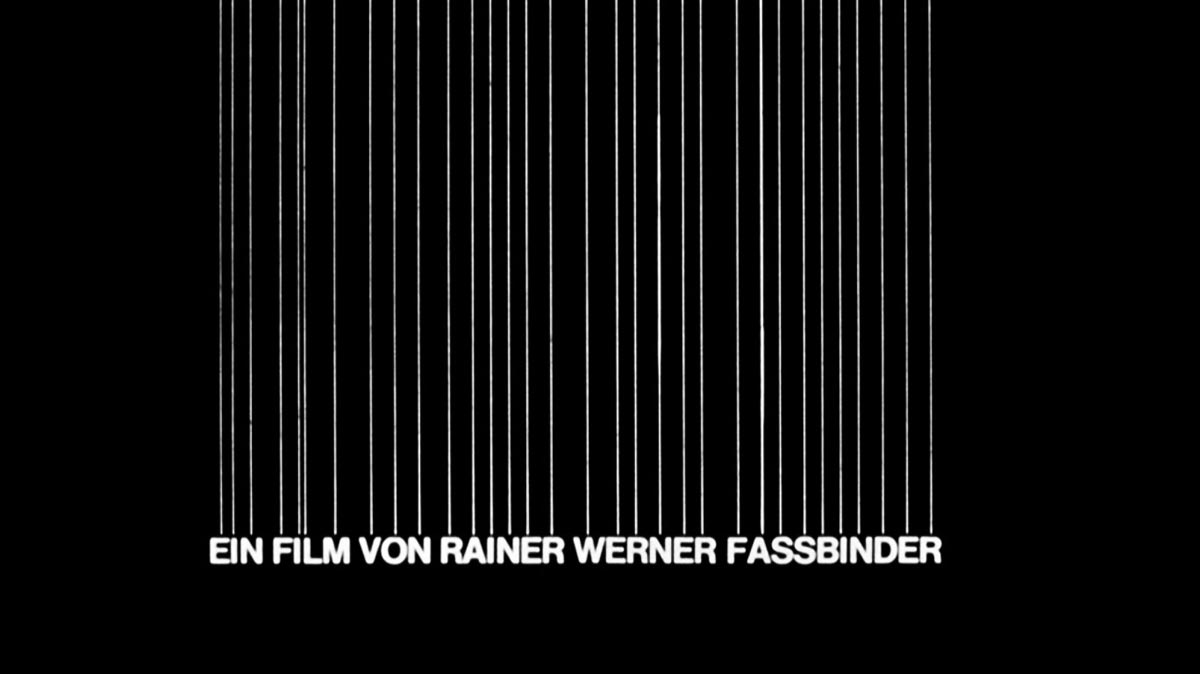
In Douglas Sirk’s All That Heaven Allows, Jane Wyman, lonely, separated from her “inappropriate” lover Rock Hudson, sits at a Christmas gathering, heartbroken and unhappy with her life. Her daughter, finally realizing her mother actually loves the soulful, younger gardener (finally?), feels for her mother, while her imperious, smug son settles on the couch and blithely talks of both going to Europe and selling the house. Her house. He makes a point to say “one person” doesn’t need such a big house with the word “one” stabbing Wyman right in her heart. The kids will be gone, and the widow is now looking at a life truly alone – love be damned. She breaks down and says to her daughter: “The whole thing’s been so pointless.” And then … her son presents mother with her Christmas present. It’s a television set. A man enters carrying the unit and “sells” her on this box of entertainment, this replacement human being. Wyman looks into the unplugged screen, despairing and even a bit frightened (this is her future?) and sees her reflection. The man proclaims: “All you have to do is turn that dial and you have all the company you want, right there on the screen. Drama, comedy, life’s parade at your fingertips.”
Shot from the perspective of Wyman’s distressed reflection in the television screen, we see her visage trapped in a frame, peering at herself and the prospective imitation of life, unplugged but waiting, like the horrifying company a solitary pill-popping Ellen Burstyn will keep in Darren Aronofsky’s Requiem for a Dream. The expectation of sinking into the void of replacement reality to human life is not only one of the most heartbreaking moments within Sirk’s oeuvre, it’s one of the most horrifying as well. It’s also, intriguingly, an early disavowal of the alienating aspects of technology, Sirk using his famous replication mirror shots to emphasize the fear of simulated existence. Once that TV is turned on, her disturbed replicant face will be blurred by life’s “parade,” and she will likely succumb to its numbing, anesthetizing comfort. We never do see that TV turned on and based on the film’s ending, we assume Wyman will shove it out the door like Craig T. Nelson in Poltergeist. But with World on a Wire, I feel like Sirk disciple, young Rainier Werner Fassbinder, sneaked into that gorgeous Alexander Golitzen-designed room when no one was looking, plugged that life-sucker in, and turned the nob to “on” – and with a hard click.
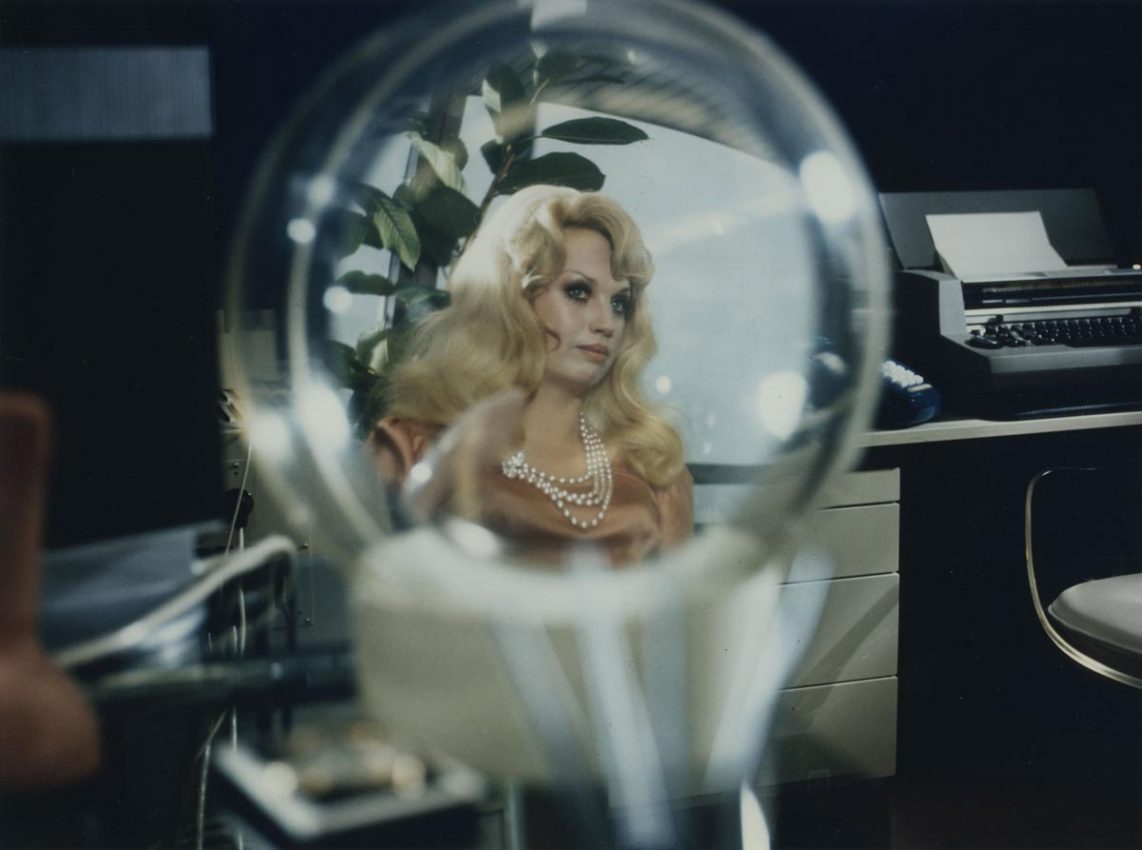
With that fantasy click, Fassbinder wasn’t just thinking science fiction when he made his one and only sci-fi epic, World on a Wire, he was likely, in part anyway, thinking of Sirk. Fassbinder and Sirk are often thematically and stylistically linked by critics, World on a Wire is no exception (and Fassbinder, serious devotee and student that he was, discussed Sirk himself). Jane Wyman could be inadvertently gazing towards another kind of future when thinking of the Fassbinder’s mirror shots – World on a Wire is a movie so crammed with mirrors and reflections, that the picture takes Sirk’s idea of a mirror’s view of a warped or opposite reality, and transplants its ophthalmic impersonations into science fiction; and most specifically, and fittingly, into a movie about virtual reality. Replacement humans. Fassbinder works with science fiction ingeniously, layering his prescient story and characters with themes many of his other picture’s explore — power dynamics in relationships, identity, societal perceptions, how we observe from inside a film as characters and outside of a film as voyeurs, how we style our lives, and how we inhabit the style around us.

And, again, style. This picture is mad with style – as chic as Petra von Kant’s designs and her artfully crafted bedroom/set, it often looks like a work of installation art, in which characters at pool parties stand like mannequins or float like ghosts, shimmering blue water lighting faces, gleaming plastic surfaces, white statuary adorning 70s sci-fi/mid century modern rooms with pops of color from telephones, TV screens looking back at us, and of course, mirrors everywhere, sometimes as many as three or more in one shot. Women traipse around sexily, listlessly in gowns for day attire, men don fedoras and sharply tailored suits, our hero drives a white corvette, looking more like a noir hero or a suave super spy than his job title – technical director of the Institute for Cybernetics and Futurology.
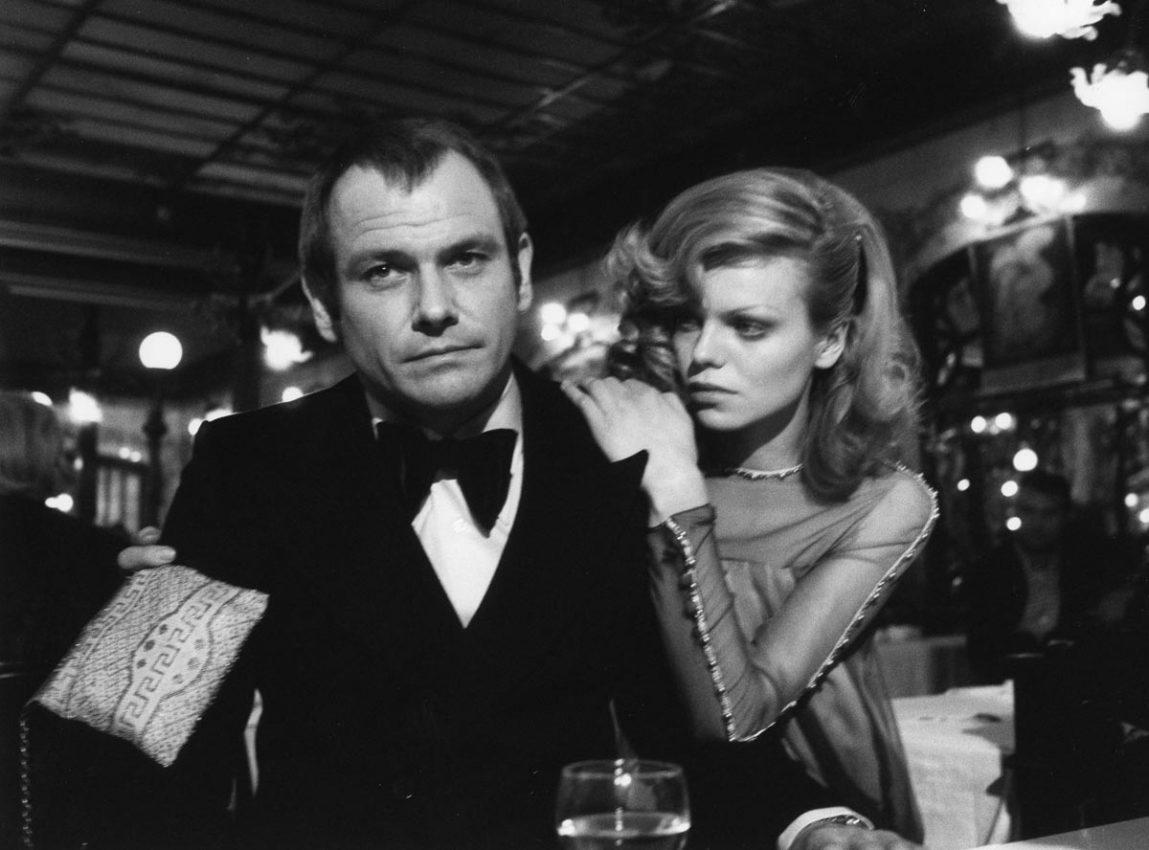
That hero is played by Klaus Löwitsch – handsome and charming, with a wry expression and a unique, subtle sense of humor – he’s a 70’s-styled noir protagonist (he’s been compared to Bogart, but I find him more of a cross between Dana Andrews and Ralph Meeker). Fassbinder uses Löwitsch’s physicality to wonderful effect here, even having the actor dive out of a cabin before it explodes (which is highly amusing). Or making him climb, simian like, over a wired fence (also amusing.) Much in this movie is satirical or strangely humorous while telling its story sincerely and chillingly, and in ways that bend what we perceive as homage or dead serious – it’s everything at once. We see Kubrick (2001), we see Godard (Alphaville, and with its star, Eddie Constantine, making an appearance), we see simulated Marlene Dietrich (twice, via Ingrid Caven, and once acting out the famous death in Josef von Sternberg’s Dishonored) and, as I said, we see Sirk. But this is a Fassbinder picture through and through.
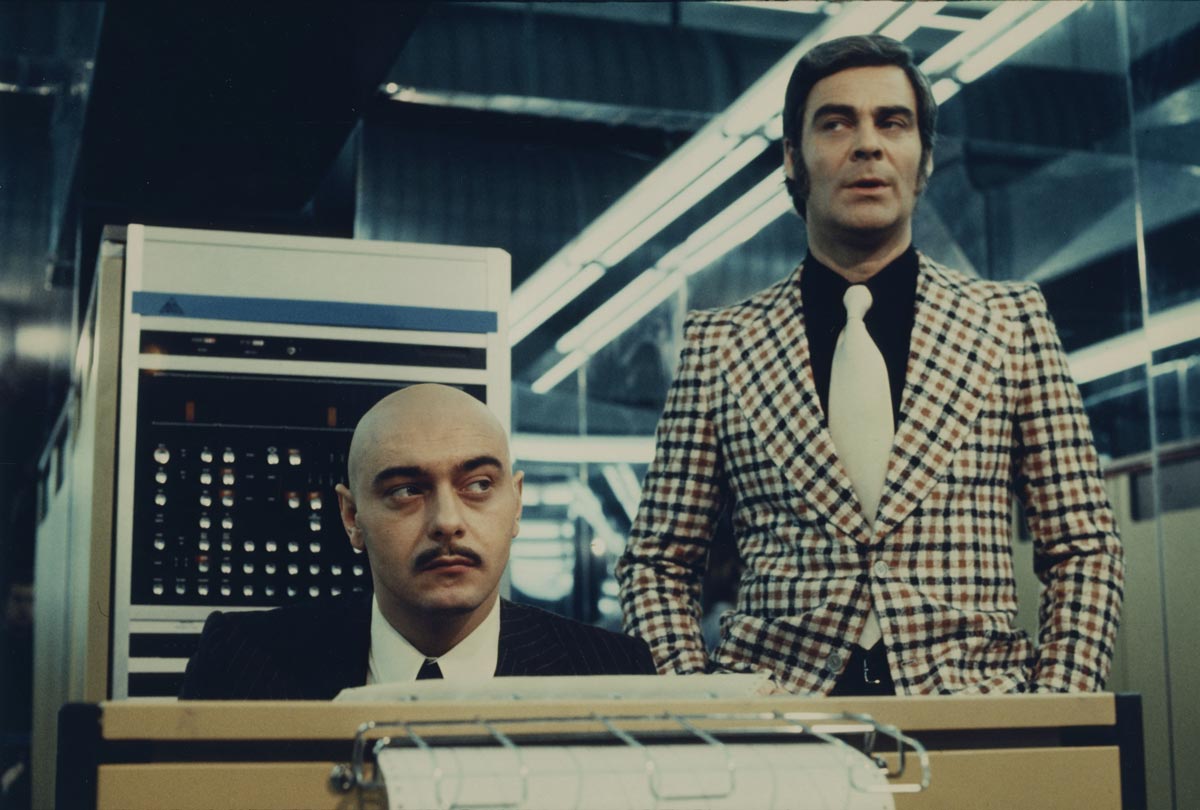
Largely unseen in the United States until 2010 after a dazzling digital restoration by the Rainer Werner Fassbinder Foundation, World on a Wire originally aired, not in theaters, but on German television in 1973 as a two-part tele-movie. And this is most certainly a TV movie made by Fassbinder – art directed like crazy (by Kurt Raab, who also acts in the movie), gorgeous 16mm, the film is shot by Fassbinder regular, cinematographer Michael Ballhaus, with such artful meticulousness, the camera moves and zooms and follows extended takes with fluid grace; the movie alternately waltzes and lurches in this gorgeous dystopian delirium. It’s weirdly hypnotic, and uncomfortably soothing, if those sensations can be possibly felt simultaneously. With World on Wire, they are.
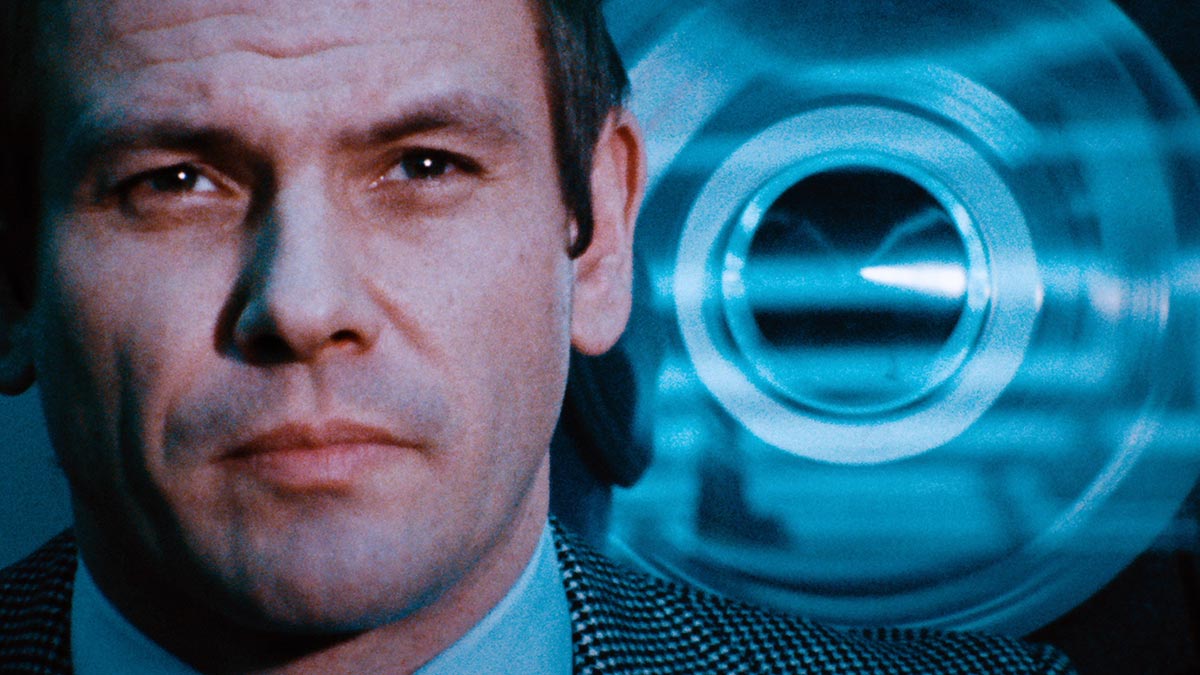
Adapted from the 1964 novel “Simulacron-3,” the three and a half hour series features Löwitsch as a scientist, Dr. Fred Stiller, who takes over for a mysteriously deceased Professor Volmer (Adrian Hoven) as the Institute director to a simulation program featuring over 9,000 “identity units.” The simulated humans live in the world unaware of their mirrored existence, playing humans, thinking they’re human and going about their business in what they perceive as one world – actually it’s split world, or existing in a hierarchy of real and perception – a top world and a bottom world. Stiller has already inherited a position under mysterious circumstances, but his existence becomes even more warped, stranger and sinister: mysterious disappearances, glitches in the identity units, corporate corruption and control, perceived madness on the part of Stiller, his terrifying, mind-bleeding headaches, assassination attempts, he’s even accused of two murders he didn’t commit. Stiller spends a good portion of the film’s third act fleeing, searching for an important contact to make sense of this real world and the simulated one. And he keeps running. He runs so much that he nearly gives up – once when the men with the white jackets (two extraordinarily creepy looking actors) come to capture him, he slowly dresses, and after enough time, jumps out of his room, exhausted (observing him barely make it out due to his own fatigue is disturbing and humorous). And another time when Vollmer’s daughter, Eva (an intriguingly somnambulant Mascha Rabben), pulls a gun on him; she hands it to him to reassure Stiller, and so he slowly aims it towards his head, distraught, but also as if he’s trying it out. It’s an act. With that, it’s played like how we’re watching someone think about the idea of this chunk of metal to their head, how it could blow out their brains, but … that’s too real? It’s not just as much as Stiller’s will to live that he thinks twice about it, but that it’s too much of a life or death choice, and within his own control. He does not pull the trigger.
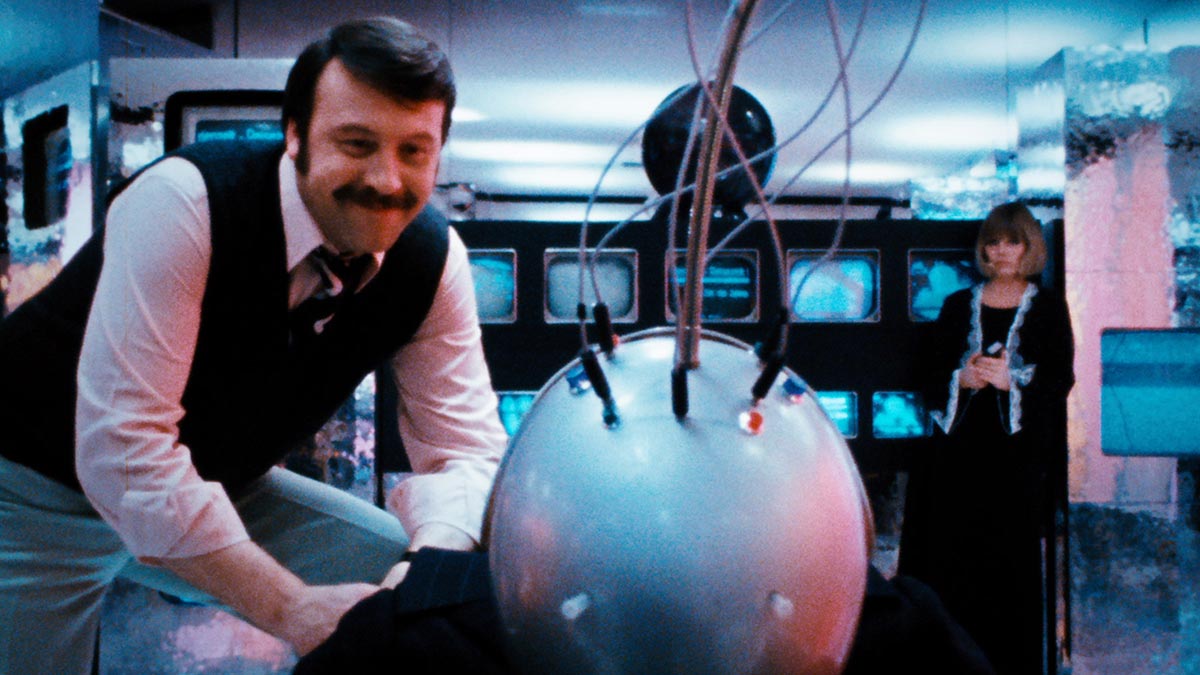
That Fassbinder was exploring the virtual world, and before The Matrix, Blade Runner, Tron, Videodrome, eXistenZ and other later pictures (Philip K. Dick was writing about these ideas early on) is another fascinating corner of the young, absurdly prolific genius’s mind. His interests and imagination were boundless (I’m not going to list all of the films he made before dying at age 37, but there were 40 features, not counting TV, shorts and plays) and so the idea of looking at reality through an alternate reality likely merged with the filmmaking process itself. Fassbinder was 27 when he made this series, and in a year that would produce three other works: Nina Helmer, Martha and Ali: Fear Eats the Soul. He assembled many of his recurring actors: Löwitsch, Barbara Valenin, Raab, Margit Carstensen, Ulli Lommel, etc., mixed with older German actors and interesting cameos – one from Rainer Langhans, which struck me as curious. Famous for being a member of Kommune 1, Langhans is almost known in rock lore for dosing Fleetwood Mac’s Peter Green during an infamous Munich trip that would reportedly warp Green’s mind and send him into madness. That Fassbinder chose Peter Green’s popular, soothing beautifully trippy 1969 Fleetwood Mac instrumental “Albatross” to not only fade out the first and second part of the series but to also score Stiller fleeing in his car, seems a intriguing coincidence, or perhaps he knew the story (maybe Langhams told him about it – I feel like Fassbinder would know this particular detail). Whatever the case, life, lore, Fassbinder’s methods of madness with actors, his real life chaos and precision, it all swirls together perfectly in Fassbinder’s mind-bending fantasia. (Fassbinder also had excellent taste in music, and all of the music in World on a Wire is used effectively, often unexpectedly or referentially, from Strauss’s “The Blue Danube,” to Anton Karas’ The Third Man score, to Marlene Dietrich’s “The Boys in the Backroom,” to Elvis Presley’s “Trouble,” and Gottfried Hüngsberg score is effectively portentous.)
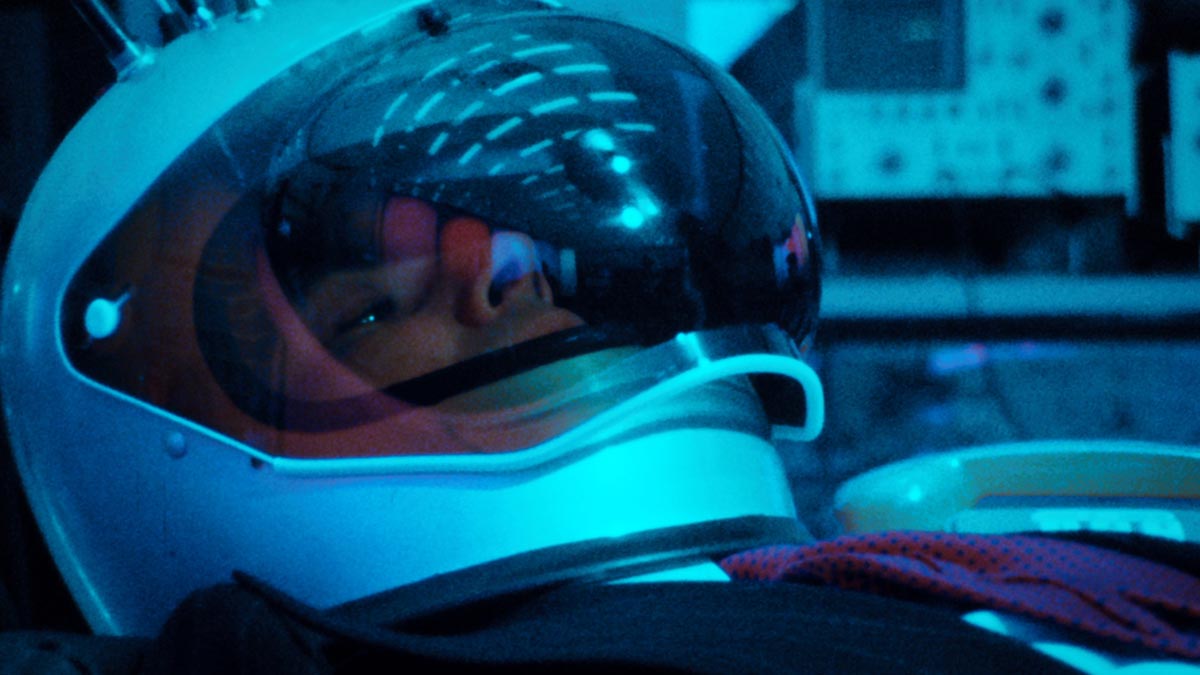
Alongside the prophetic ideas presented, the music, the look, the acting, the framing of shots, the inventive, stylized mise-en-scene – everything here – World on a Wire does not feel dated – even the old school synthesizer special effect sound punctuating a dramatic moment (or moments that aren’t dramatic – Fassbinder uses the resonance at times seemingly randomly) feels ironic and, yet, post irony. It’s funny and creepy, a B-movie effect and, yet, unsettling, as if just a sound can summon cinematic memories of childhood. Space aliens and flying saucers hovering overhead and the fears of being abducted or probed, which is not just a childhood fear.
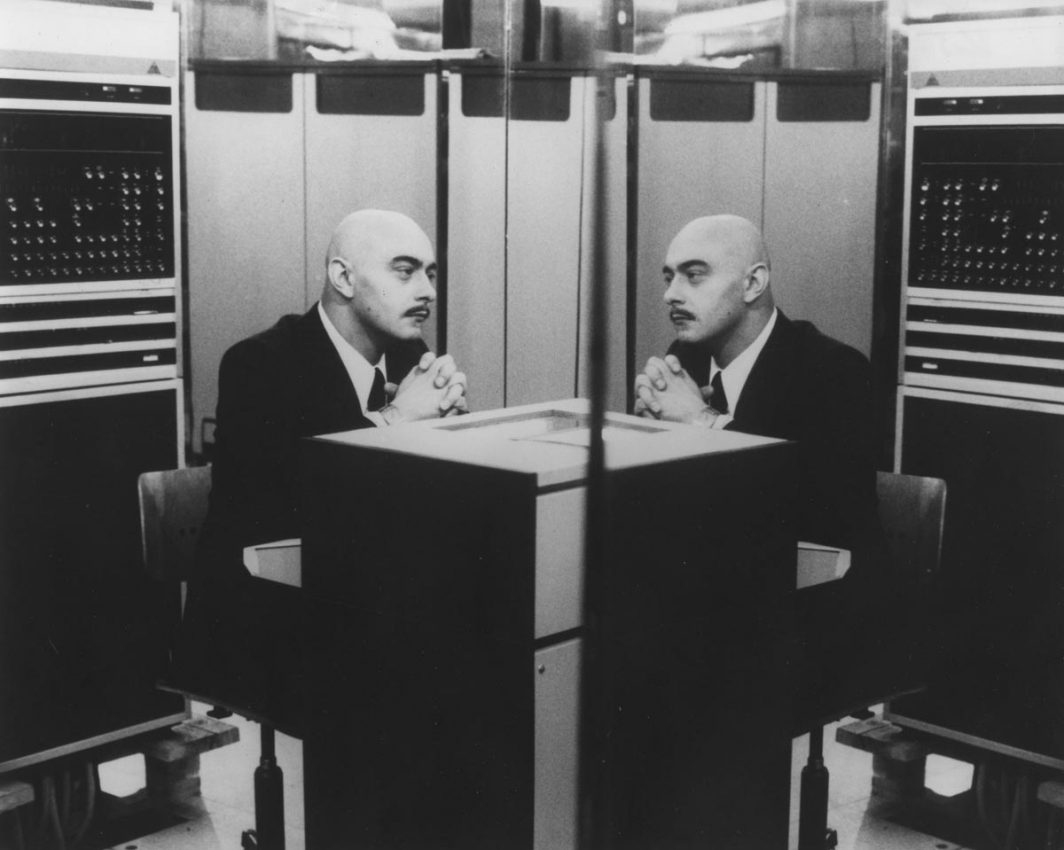
And, again, there are all of those Sirkian mirrors, reflecting another version of ourselves, a simulated reality that’s intermingled into our own perception so much that we don’t realize how bent that perception actually is. The word “delete” is used in World on a Wire, the act of ridding a simulation, which struck me as entirely of the now. We delete social media accounts, comments and people, as entire relationships are conducted solely via computer; relationships that often seem as real and as messy as physical connections. Meanwhile, we frequently feel lonelier and more depressed as we scroll newsfeeds, observe other people’s lives while observing our own selves as presented online, real or not so real. Or what does that mean anyway? It becomes confusing. We are constantly plugged in but recurrently physically disconnected (Oliver Assayas also explores this in his brilliant Personal Shopper), and we find ourselves even questioning how much we would even exist without our curated online life.
Sirk said: “The mirror is the imitation of life. What is interesting about a mirror is that it does not show yourself as you are; it shows you your own opposite.” Presumably, like simulated humans, Sirk meant that we don’t know we’re seeing an opposite of ourselves, and that is either terrifying to consider, or another mysterious facet of our unfathomable selves. Does the idea of a splintered psyche have to be considered in an entirely negative light? I’m not sure, not in every instance, but that those shards of differences are crouching inside, that is unsettling, something that would blow our minds on a bad Peter Green-style acid trip. Who are you? Go away! (The Doors of Perception sometimes shut behind you.)
The Jane Wyman television “Who are you” reflection, trapped in a screen, is especially disconcerting to consider when thinking of today. And her heartbreak of losing love and her own sense of identity; her freedom to live as she desires, brings us to the disquiet and alarmingly calming dreamscapes of World on a Wire. As I dreamed up earlier, Fassbinder turned that TV set on, and then in, a fit of All That Heaven Allows anger in Ali: Fear Eats the Soul, sits next to the character who kicks that TV set in the face. But by that point the television is an ubiquitous fixture in a living room, not a strange new world. After all, World on a Wire was made for TV. So, there’s another level of projections to consider, beyond the tube. You’re staring into it now. You can probably see your reflection in the glass. “Life’s parade at your fingertips.”


